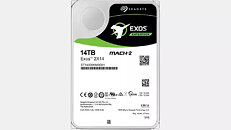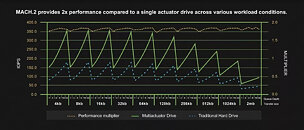Monday, May 24th 2021

Seagate Announces Seagate Mach.2 Exos 2X14 HDD With Up to 524 MB/s Sequential Speeds
Seagate has announced what currently amounts to the fasted HDD storage available in the market. The Seagate Mach.2 Exos 2X14 is available in a 14 TB capacity. What Seagate has, smartly, done, is integrate a dual 7 TB HDD system within a helium-filled 3.5" chassis. The drive features a standard 7200 RPM spindle speed, offers 256 MB cache, and uses a single-port SAS 12 Gb/s interface.The Exos 2X14 should be recognized by systems as two independently addressable logical drives.
Seagate's Exos 2X14 boasts a 524 MB/s sustained transfer rate (outer diameter) of 304/384 random read/write IOPS, and a 4.16 ms average latency - but of course, being an HDD solution with spinning platters and actuators, random performance still suffers tremendously against even its SATA SSD counterparts. Power consumption has understandable gone up for this solution - an Exos 2X14 drive consumes 7.2 W in idle mode and up to 13.5 W under heavy load. Seagate is offering its PowerBalance features integrated into the Exos 2X14, which aims to reduce its power consumption within the 12 W power envelope usually associated with 3.5" HDDs, but Seagate says this "does come with a performance reduction of 50% for sequential reads and 5%-10% for random reads." The need for higher IOPS-per-TB performance in their HDD space so as to allow datacenters to offer adequate performance for high-capacity storage continues to bear fruits.
Source:
Tom's Hardware
Seagate's Exos 2X14 boasts a 524 MB/s sustained transfer rate (outer diameter) of 304/384 random read/write IOPS, and a 4.16 ms average latency - but of course, being an HDD solution with spinning platters and actuators, random performance still suffers tremendously against even its SATA SSD counterparts. Power consumption has understandable gone up for this solution - an Exos 2X14 drive consumes 7.2 W in idle mode and up to 13.5 W under heavy load. Seagate is offering its PowerBalance features integrated into the Exos 2X14, which aims to reduce its power consumption within the 12 W power envelope usually associated with 3.5" HDDs, but Seagate says this "does come with a performance reduction of 50% for sequential reads and 5%-10% for random reads." The need for higher IOPS-per-TB performance in their HDD space so as to allow datacenters to offer adequate performance for high-capacity storage continues to bear fruits.



37 Comments on Seagate Announces Seagate Mach.2 Exos 2X14 HDD With Up to 524 MB/s Sequential Speeds
Still, my mouth waters.
I like the idea of giving more sequential-speeds per unit, but I don't think that many people are actually limited by hard drive bandwidth. But... maybe I'm wrong on that. Clearly this strategy delivers more IOPS and bandwidth in a given rack-unit (4U or whatever). But certainly not IOPS or Bandwidth per dollar.
It's not too hard to make this one 14TB drive with Storage Spaces (or you could run Raid 1 for data redundancy) but that is an important distinction.
EDIT: Ninja'ed, lol
At 200MB/s per 8TB HDD, that's 8GB/s of bandwidth in the 40x HDD configuration, or sufficient to max out a 2x40 Gbit fiber connection. Hmmm... ~100 IOPS per HDD is ~4000 IOPS for the whole device. This Mach 2 EXOS would be a significant cost to increase that to 8000 IOPS (for 40x HDDs), or maybe 16000 IOPS (for 80x HDDs).
EDIT: also smaller scale things like company network storage, where you don't have that much money and space at hand, because these giant storage systems still need something that runs them.
EDIT: Seemingly what I read was only half true, it can act as one in most systems due to it being only a logical, but not physical, split, it can be fully individually addressed too though.
But obviously, I haven't used these drives yet. I'm curious how they really are used.
2x28 LMAO.
So my old 256GB plextor M3s ssd I gave a buddy is still running strong as a primary drive, almost 10 years old.
www.storagereview.com/review/plextor-px-m3s-ssd-review
When todays' generation hdds can do that call me.
My comment still stands about all current day hdds though.
www.seagate.com/files/www-content/solutions/mach-2-multi-actuator-hard-drive/files/sc702.2-2101us-mach-2-faq.pdf